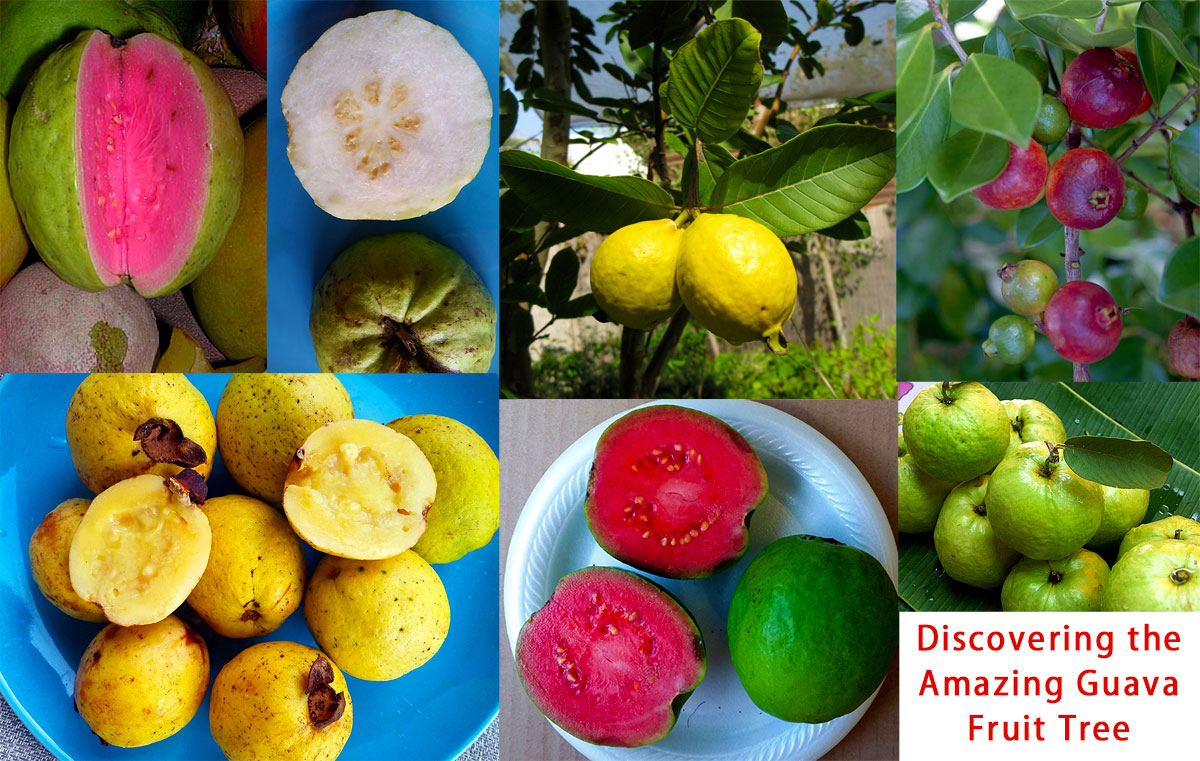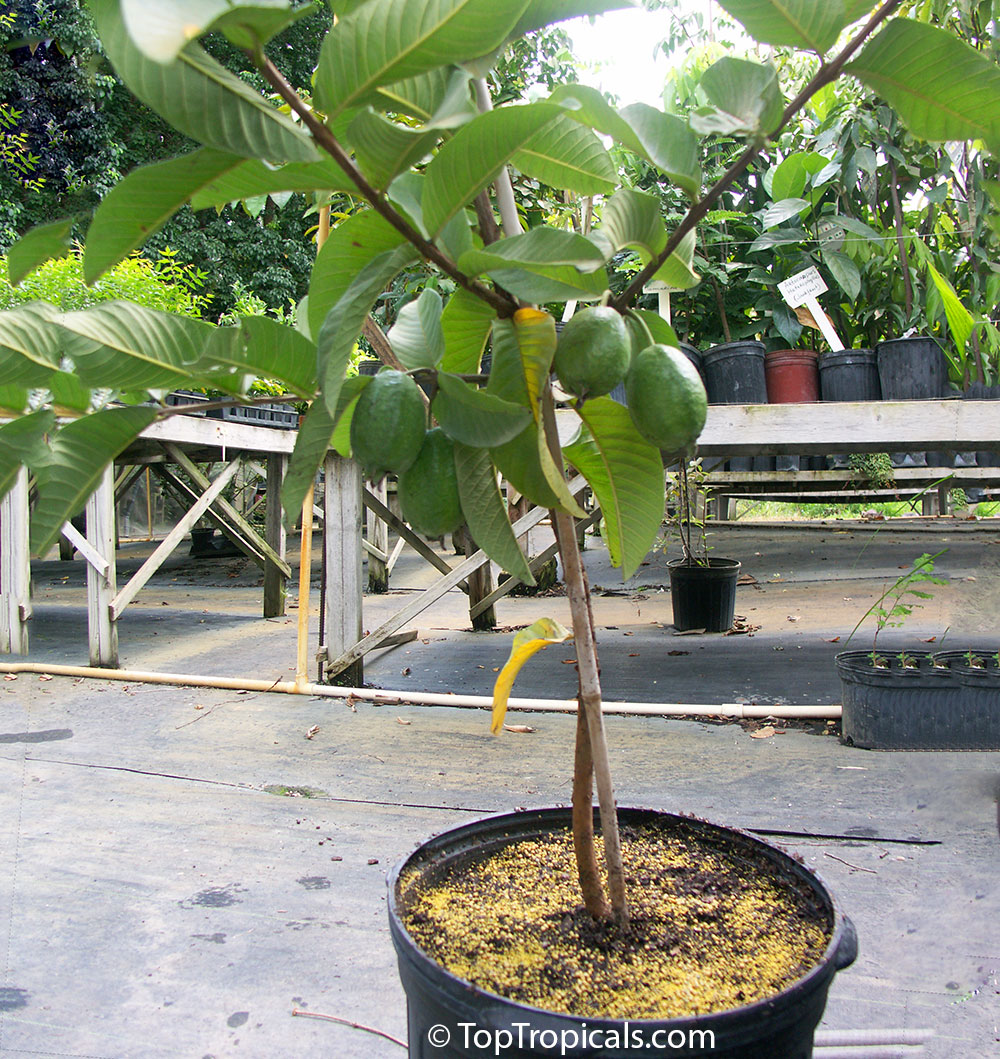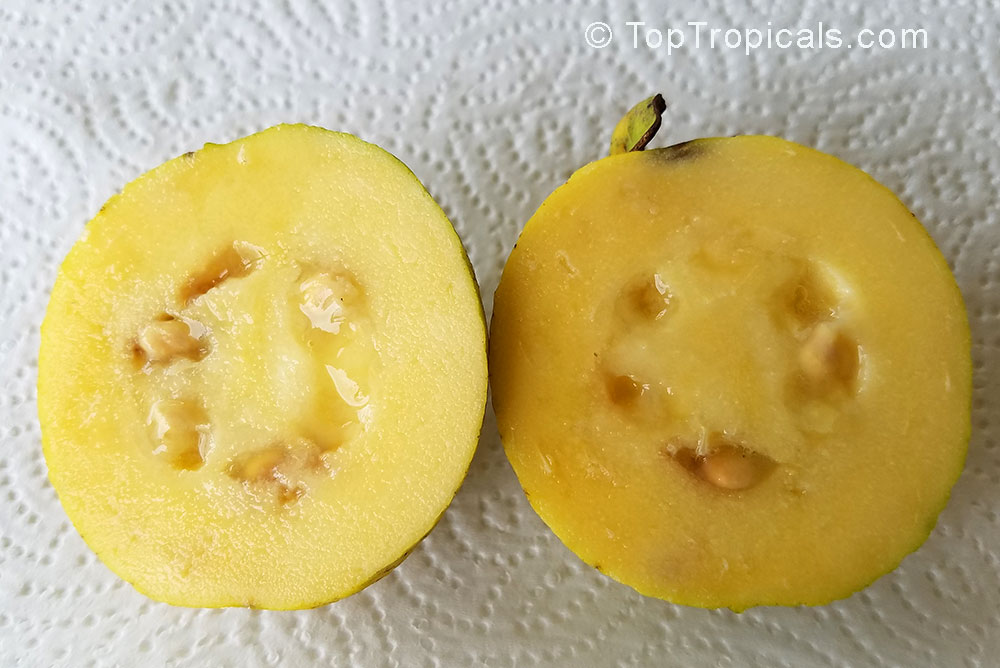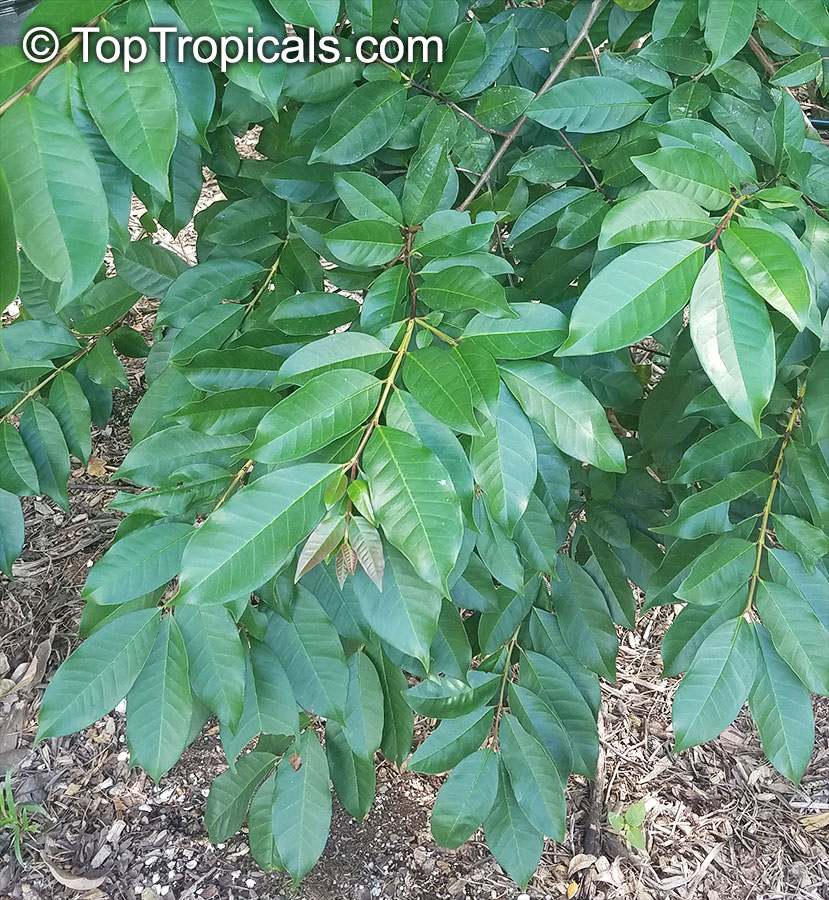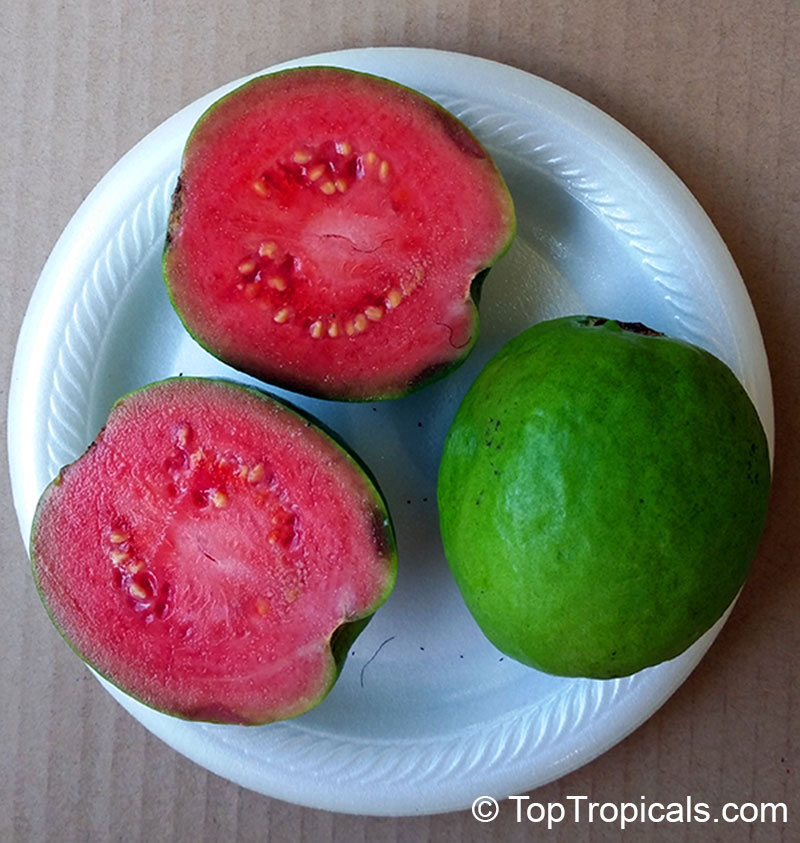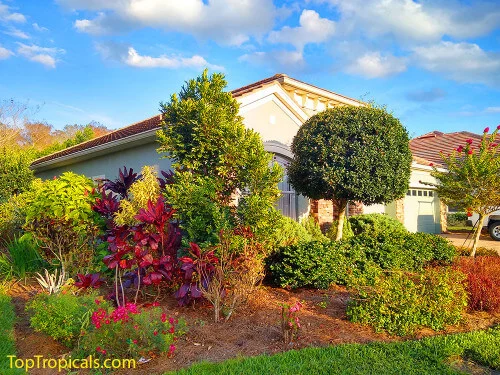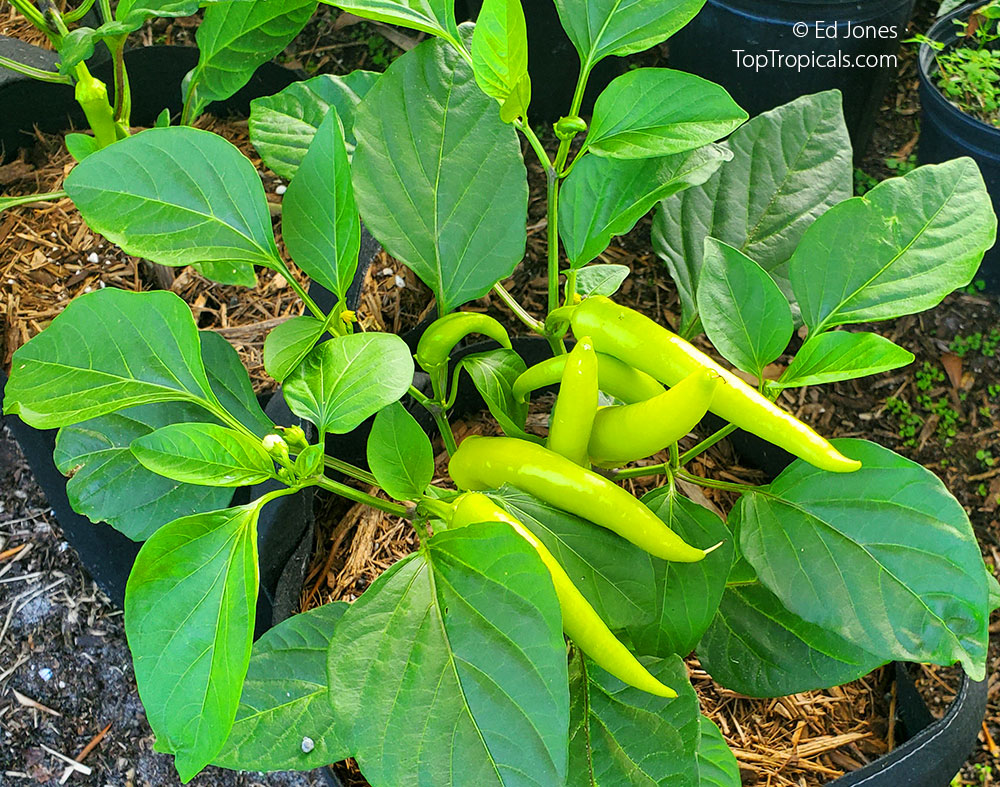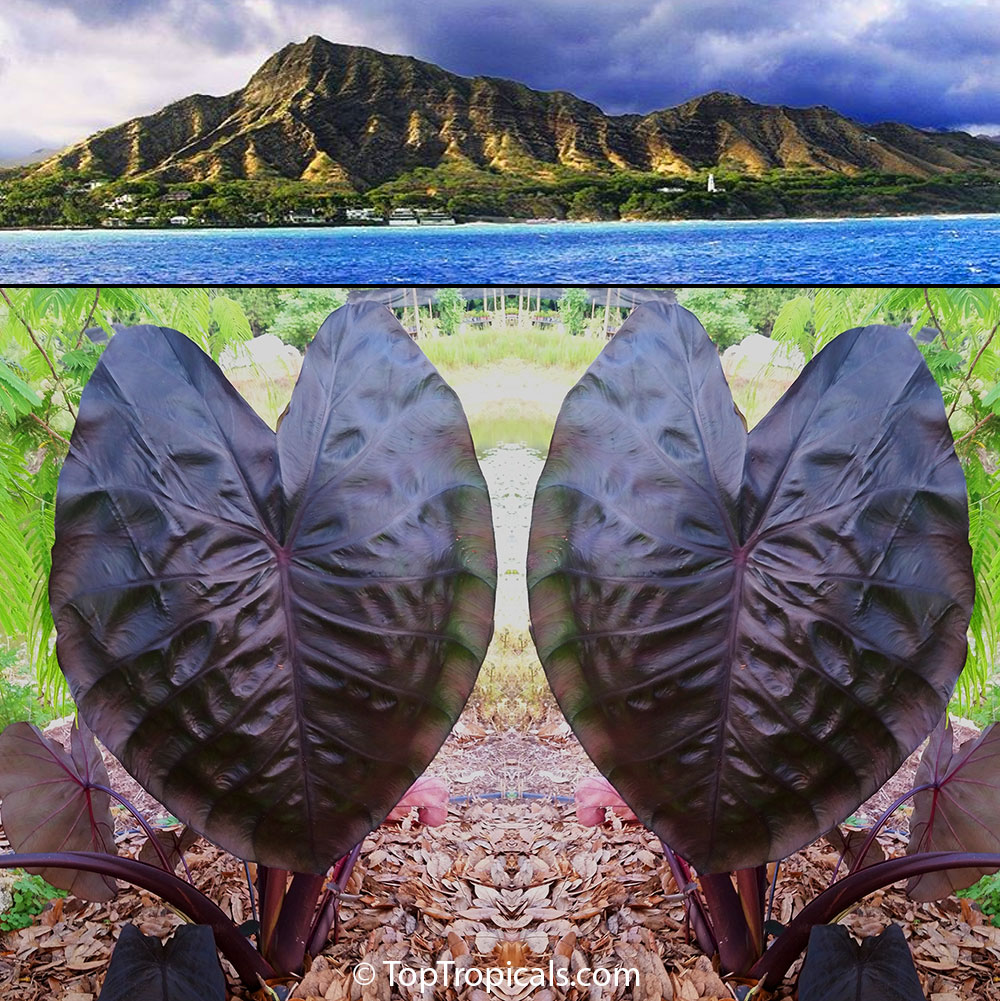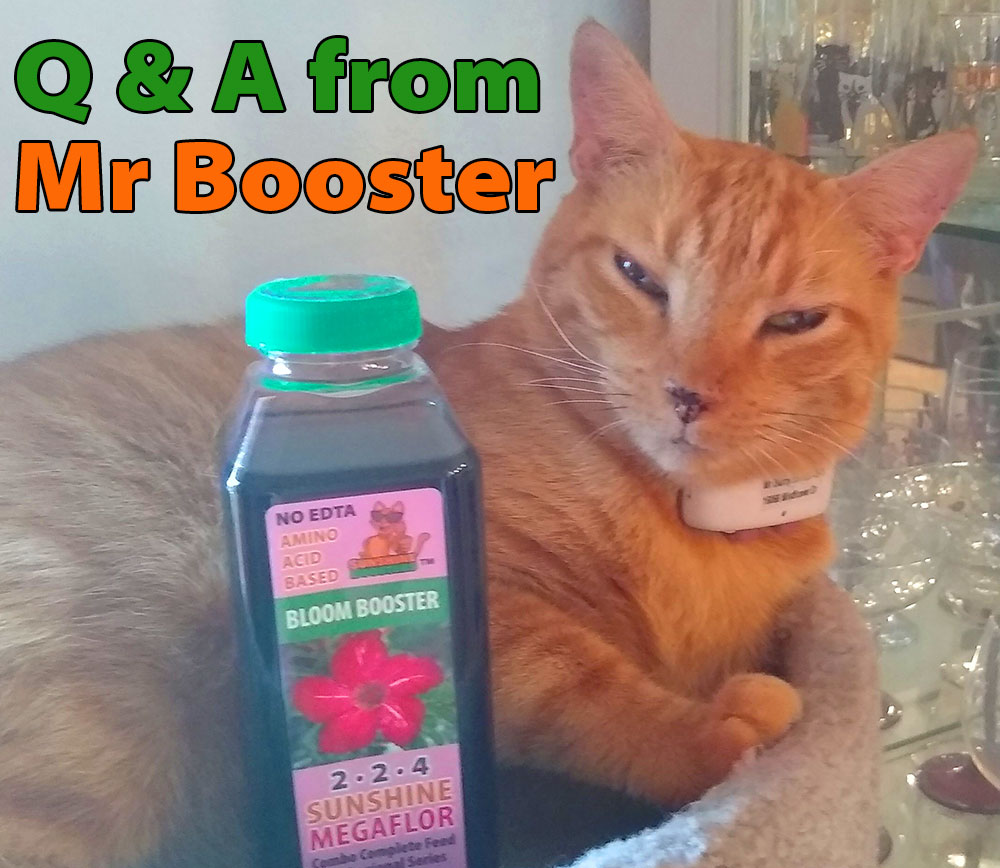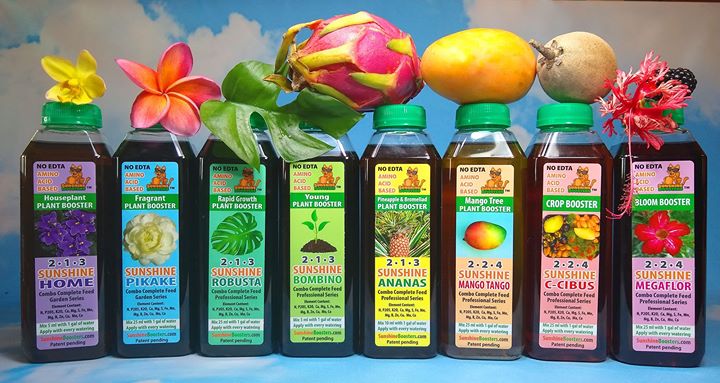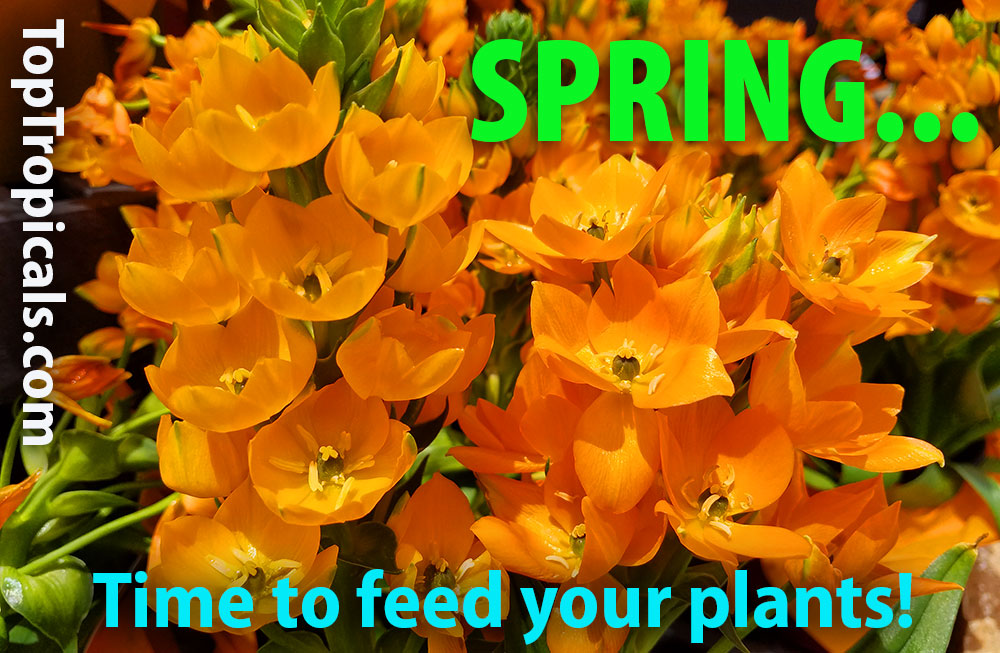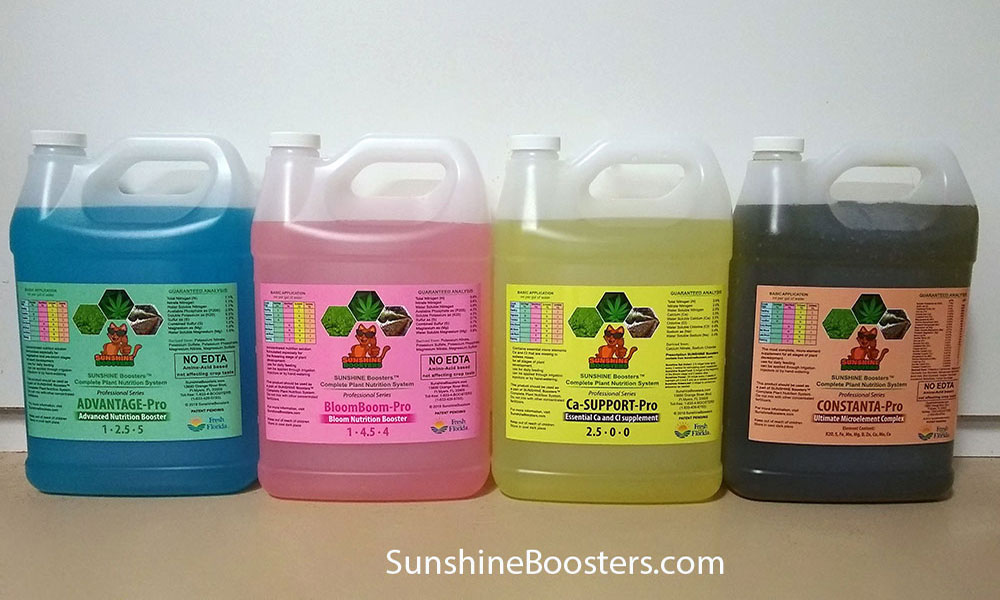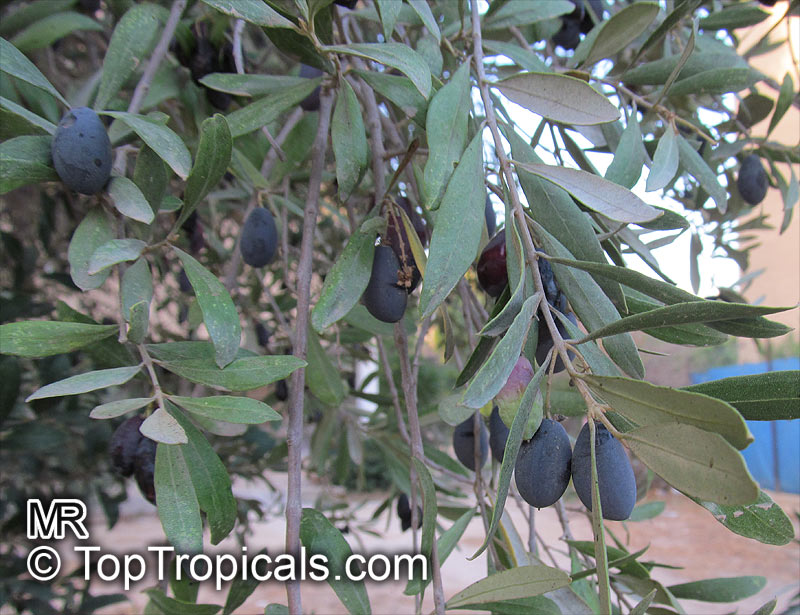Garden Blog - Top Tropicals
Date:
Discovering the Amazing Guava Fruit Tree
A Gardener's Delight:
How to grow Guava Tree, delicious recipes and more...
Imagine stepping into your garden, plucking a fresh, juicy guava off a tree, and savoring its sweet, tropical flavor. Sounds delightful, doesn't it? Guava trees are not only a wonderful addition to any garden but also offer an array of delicious and nutritious fruits. Let's explore the fascinating world of guava fruit trees, dive into the different species, and share some tasty ways to enjoy this remarkable fruit.
If you're blessed with a warm climate, find a sunny spot with well-drained soil for your tree. Water it regularly, especially during dry spells, and keep it well-fed with a balanced fertilizer. Pruning is essential for maintaining a bushy, healthy tree that'll reward you with an abundance of fruits...
Date:
Grow Your Own Food:
Costa Rican Guava - Guava for Drinking!
by Alex Butova, the Witch of Herbs and Cats
...Looking for a handsome, unusual fruit tree for container culture with healthy and flavorful fruit? Or simply want an easy fruit tree that is hardy and undemanding? Psidium friedrichsthalianum (family Myrtaceae), the Costa Rican Guava or Cas Guava, is a perfect small guava tree that can be very rewarding. In Nicaragua it is called "Guava for Drinking" or "Fresco de Guava". Despite the tartness, the flavor is excellent with passionfruit and pineapple tones and is much more pronounced than the subtle flavor of the common Guava. These fruits are very much a part of the culture and cuisine of Costa Rica. Also it has been successfully grown in California now and can be grown in many subtropical regions or as a container plant - "condo" fruit tree...
Date:
Guava, the easiest container fruit tree
Grow Your Own Food
Guava is one of the most popular and well-known tropical fruit because
it is so tasty, sweet, juicy and flavorful! Many people are familiar with it
because of the large number of products made from this aromatic fruit. But
very few people know that Guava tree culture is very easy and this plant can
fruit in a pot right away. Guava tree start blooming and producing fruit as
small as 1 gal pot size. It can be kept in compact shape, responds well to pruning, stays bushy and grows very fast. It
is a perfect container fruit tree or a specimen for a tropical garden of any
size.
Upon ripening, the fruit becomes soft and juicy. It may be eaten fresh,
made into a juice or nectar contain fruit pulp, or made into preserves, jam,
jelly, or paste. A distinctive, savory-fresh aroma of fruit is thermo-stable,
thus survives processing. The guava is an excellent source of vitamins C and
A.
The plant is relatively cold hardy. Our young trees, 3 months after being
planted in the ground were exposed to a short period of freeze last winter
(mid-20's) but they grew back without significant damage. Try to keep Guava
cold-protected for the first winter, then it will be much hardier once
established.
Guavas are fast growers and heavy feeders, and benefit from regular
applications of fertilizer. Make sure to get some Sunshine Boosters fertilizer: Sunshine
C-Cibus - Crop Booster, and feed them your round.
Date:
Organic or inorganic fertilizers, which is best?
A very smart article by Fedor, Mike, and Ed
Q: Which one is better - organic or inorganic fertilizer?
A: When it comes to fertilizer, gardeners always wonder if one better than the other. Does a total organic fertilizer make sense for you? Is it easier to just use a cheap granular fertilizer a few times per year? You may be surprised to learn that there is one fertilizer that has advantages over both!
While organic fertilizers may be all the rage, there is the difference
between Sunshine Boosters
fertilizers, organic and inorganic fertilizers. Sunshine Boosters fertilizers have been especially developed to provide optimal conditions for cultivating crops in pots and greenhouses. These specialized nutrient blends are essential in order to
maintain an appropriate environment for successful crop production, as they
compensate for the lack of natural beneficial bacteria and nitrifying
organisms which are specific to open soil cultivation.
Learn about why Sunshine Boosters is the best choice...
In the photos: Hungarian hot wax pepper (above) and a Baby Cucumber (below), both grown in Ed's organic garden with Sunshine Boosters
Date:
New Video:
Dwarf Guava Hawaiian Rainbow
Psidium guajava "Nana"
Put a little Aloha in your garden... A guava that will bring a taste of the Islands!
This is a very small version of the favorite aromatic Guava - Nana. It grows only up to 5-6 ft tall with a short trunk and a branching, bushy habit. It is perfect for those who have limited space. It can be grown in a pot and fruits heavily. Provided with warm conditions, the tree can bear fruit almost year around. The fruit is round, about 2", pretty good size for a dwarf tree. The flesh is sweet, aromatic, and
varies from white to yellow to pink.
Subscribe to our Channel:
Stay updated with TopTropicals Videos by subscribing to our channel at YouTube.com/TopTropicals and get our latest video news of what is fruiting and blooming!
Date:
Easy Sunday Morning Deals: Dwarf Guava Hawaiian Rainbow
Saving on your favorite plants is Easy.
Easy like Sunday Morning...
..."A ' ohe loa i ka hana a ke aloha.
Distance is ignored by love..."
- Toni Polancy -
It's time for our favorite day and another Easy stroll through Top Tropicals Garden with savings of
50% and MORE!
Put a little Aloha in your garden....
Two Exotics from Paradise
It may be cold where you are, so take a trip with us to the Hawaiian Islands. Tropical breezes,
soothing ocean waves and an unbeatable selection of tropical plant treasures...
This week we bring the Aloha to you. A guava that will bring a taste of the
Islands and a spectacular variety of Majestic Taro.
Dwarf Guava Hawaiian Rainbow
- Ready to fruit this year! -
This is a very small version of the favorite aromatic Guava - Hawaiian Rainbow Nana. It grows only up to 5-6 ft tall, perfect for limited space. It can be grown in a pot and fruits heavily almost year around. The flesh is sweet, aromatic, and varies from white to yellow to pink.
Colocasia Diamond Head
- Large Developed plants! -
Diamond Head is a spectacular variety of Taro is named after the volcanic cone on the Hawaiian island of Oahu - both the cone and plant are black and lustrous! Mature plants form a well-behaved clump and reach 3 to 4 feet tall, with leaves up to 2 feet wide! A must for black plant fanatics. Grows more compact that other Colocasias and no two leaves are the same!
Colocasia Diamond Head,
regularly $42.95,
is on Easy Sunday sale for only $21.48
Dwarf Guava Hawaiian Rainbow, regularly $52.95,
is on Easy Sunday Sale for only $26.48.
Combine the two for maximum Aloha and save even more:
only $42.95 for both - one plant comes FREE!
Remember, the Easy Sunday Deal expires on Monday January 17th.
Date:
Varieties of Guava
Q: We were just in Australia where guava juice was available in the markets. Pretty sure I can grow different varieties of Guava's here, as I have 3 already, but wondering if it would be psidium guajava or littorale as the best bet for making the pink juice we enjoyed. Thanks so much, your plants are so healthy when they arrive!
A: Both species are used for commercial juice making. We grow lots of Psidium littorale - Cattley Guava, Strawberry Guava - and we make delicious juice. Psidium guajava - Tropical Guava, Guajava - is less juicy, fruit is somewhat dry, but it still has a great flavor; you may need to add water to blended pulp. And sugar - add it to both kinds of fruit!
Check out our Guavas!
Date:
Sunshine Boosters: Healthy Plant Food
Q&A from Mr Booster
This year we introduced many new items to Sunshine Boosters selection - for all your plant needs in the garden. We receive lots of feedback and questions, so it is time now to share this information with all our customers and open this new section in our Newsletter -
From Mr Booster: Q&A
We promise that we will keep up with your favorite Cat of The Month blog as well!
Dry, liquid, or both?
Q: I have bought different plant boosters, and I am so exited to use them on my plants! I understand that Sunshine Boosters are better than traditional fertilizers, should I give up dry fertilizers all together, or can I continue using them? They are so easy, don't require any mixing...
A: We are all busy and it seems at first like a little bit of
work with all the mixing, but it saves your time in a long run! And money
too.
When we used dry fertilizers, every now and then a plant got killed, some
looked undernourished (or over-fertilized) and unhappy. It was always a
challenge to figure out which plant needs more and which needs less, and how often.
It made us use more and more chemicals trying to adjust the feeding balance,
and we had to worry about why a plant doesn't look happy. Sometimes we lost rare, valuable, collectible plants since we couldn't find a cure for their illnesses.
With Sunshine Boosters, those problems are gone now! See examples.
Compare using Sunshine Boosters with eating healthy, well-balanced food.
You can still survive on junk food and won't die from starvation, but eventually eating junk food will take its toll and create health problems. So you will end up trying to fix them with more and more medicine... which in turn will create more side effects.
By using Sunshine Boosters, you provide all necessary elements and vitamins
to plants without a risk of side effects or building up unnecessary
junk/toxins in their system. No more leftovers!
According to tests, Sunshine Boosters are used up completely through plant metabolism, making them healthy, strong, and disease resistant. Sunshine Boosters are based on organic amino-acids which is the foundation of life on Earth. This helps to eliminate nutrients lock up in soil. See why Sunshine liquid fertilizers are better than dry fertilizers.
To answer your question, we recommend to switch to liquid Sunshine Boosters. It is possible to additionally use dry granulated "smart-release" fertilizers for in-ground plants, no more than once a month and only during hot season (Sunshine Boosters can be used year-round). However, some customers ran independent tests and admit that using Sunshine Boosters alone is more effective than in combination with dry fertilizers. See review from Karma Nursery.
Garden Series, or Combo Total Feed Collection - all nutrients in just one bottle, for different plant types. See booster in this collection, for different types of pants.
Date:
When plants are ready for a meal?
Q: We have an early Spring here in Florida. All plants in my garden flushing out new leaves and buds opening. Can I start fertilizing? I have Mango, Avocado, Peach trees, many medicinal herbs and flowering shrubs: Angel trumpets, plumerias, bromeliads. I prefer mild organic fertilizers; can you suggest something that is safe for edibles and butterflies?
Q: As a rule of thumb, tropical gardeners start regular fertilizing when the minimum temperatures (at night) go above 65F. Keep in mind that Sunshine Boosters fertilizers can be applied year around because they have mild formulas and used with every watering; during cooler period, you water less frequently, so feeding is reduced accordingly. Another advantage of Sunshine Boosters - they are natural (derived from organic amino acids which is the basics of Life). They are safe for edibles as well as pollinating insects.
Here is the feeding plan for your plants:
1. The most universal solution for all plants (both potted and
in-ground): get a complete set of Sunshine Boosters Pro system: Advantage-Pro for vegetative growth, BloomBoom Pro for flowering stage, and Ca-Support-Pro + Constanta-Pro as necessary daily supplements. You will need all these 4
components for your garden.
2. Start adding these liquid boosters with every watering according
to dozing directions and you will notice amazing growth boost within a
week.
3. Apply Sunshine Epi plant hormone every 2 weeks as a foliar spray to boost
immune system and metabolism of plants and protect them from diseases. Epi
makes plants (especially young plants and those "waking up" from dormancy)
grow twice faster! It also enhances effect of fertilizers by increasing plant
metabolism.
4. After cool winter temperatures, some plants may develop element
deficiencies like chlorosis (yellowing leaves). Additional microelement boost
can be provided with Sunshine Greenleaf (iron supplement) and Sunshine Superfood (micro-elements).
5. For additional boosting of flowering and setting fruit, use the
following individual boosters:
Sunshine Robusta - for foliage plants and when you need rapid vegetative
growth
Sunshine TotalFeed - for Plumerias and other fragrant plants
Sunshine Megaflor - for Brugmansias and other flowering heavy feeders
Sunshine C-Cibus - for improving fruit production and quality
Sunshine Honey - for sweeter fruit (must be applied 4-5 times a year)
6. For young/small plants (seedlings, rooted cuttings) as well as
tender tropicals like bromeliads, and orchids - Sunshine Bombino is a perfect choice due to its mild formula.
7. To save money, order complete sets rather than individual
boosters; you will be able to safe up to 40%! Sunshine Complete Nutrition System
Kits: Combo
Kit, and Pro Kit.
If you are a fan of organic gardening, do not use dry fertilizers. While water-soluble and granulated (smart-realease) fertilizers are popular choice in plant nurseries due to their convenience, they are not as safe as liquid boosters because they create salt build-up in soil and have a high risk of overdosing/burning plant roots, especially potted plants, plants at breaking dormancy, at establishing, and at early stages of plant development. Besides, dry fertilizers may affect the taste of your fruit and herbs. See advantages of liquid boosters over dry fertilizers.
Learn more about Sunshine Nutrition System - a Natural solution for your garden.
Date:
How to grow a nice Olive tree fast?
by Ed Jones, the Booster guy
Q: I got an Olive tree from you a few months ago, planted in the ground and it is doing well, but I don't see any active growth. The tree looks healthy but still about the same size when I planted it in June. I'm old and I want to see the olives sooner than later. Any suggestions, should I give it some fertilizer?
A: Olive trees are relatively slow growers, however, with balanced nutrition they can grow much faster, as fast as a few feet per year. Check out this Article by Ed Jones where he describes how he grew nice, bushy Olive trees just within one season with a help of Sunshine Boosters fertilizers. The article shows in details how to properly use liquid fertilizer on your fruit trees.
